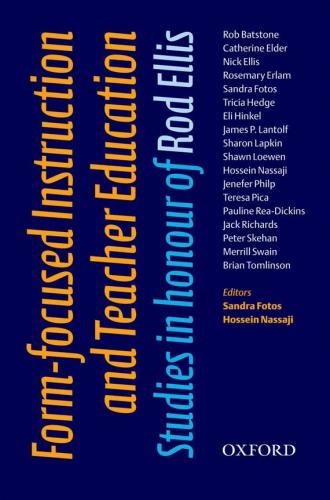With respect to the role of FFI, this research has produced convincing evidence that instruction including some kind of FFI is more effective than instruction that focuses only on meaning. This evidence has been confirmed by the results of a meta-analysis of 49 FFI studies (Norris and Ortega 2000, 2001) from which the researchers concluded that: (1) in general, FFI produces substantial gain of the target structure over the course of the study, (2) the effects of FFI seem to be sustained over time, (3) instruction that contains explicit instructional techniques results in more positive effects than that involving implicit techniques, and (4) the effectiveness of the instructional treatments depends on the methodological approaches adopted, particularly the assessment procedures utilized to measure the effectiveness of FFI.
FFI taxonomies and definitions
The evidence reviewed above relates to the overall effectiveness of FFI. However, current FFI research is concerned with issues that go beyond the question of mere effectiveness. FFI refers to a wide range of activities that differ from one another in important ways and a number of elements must be considered such as: (a) the continuum of implicit versus explicit FFI, with formal, rule-based instruction at one end, and embedding of the target structure in authentic discourse at the other; (b) the timing of FFI during the lesson; (c) the teacher’s role and intention; (d) task-based FFI; (e) the existence of input enhancement during communicative lessons designed to draw learner attention to the form; and (f) output-based FFI. Thus, a crucial question for both research and pedagogy concerns the nature of these elements and the effects they have on language learning.
A number of SLA researchers have proposed various FFI taxonomies and classifications (for example, Williams 1995, 2005a; Doughty and Williams 1998b, 1998c; Lightbown 1998; Long and Robinson 1998; Nassaji 1999; Doughty 2001; Nassaji and Fotos 2004). One of the first classifications, which has been widely cited and has had a considerable impact on our understanding of the concept of FFI, is the distinction that Long (1991) made between focus on form (FoF) and focus on forms (FoFs). FoFs, according to Long (1991, 2000; Long and Robinson 1998), is based on traditional structural and synthetic approaches to language teaching (Wilkins 1976) in which language is segmented into discrete items and is then presented to the learners in an isolated and decontextualized manner. FoF, on the other hand, involves drawing the learner’s attention to linguistic forms ‘as they arise incidentally in lessons whose overriding focus is on meaning or communication’ (Long 1991: 46). Long (2000) believes that FoF instruction is advantageous over FoFs instruction because FoF is learner-centered, is tuned to the learner’s internal syllabus, and occurs when needed. However, FoFs does not match learning processes, is not needs-based, and often results in boring lessons.
Since its conception, the idea of FoF has been widely advocated in the SLA literature. However, the construct has been interpreted and used differently by different researchers. For example, while, as we have seen above, Long (1991) and Long and Robinson (1998) conceptualized FoF mainly as reactive responses to communication problems, occurring after the event, Doughty and Williams (1998c) have suggested that FoF can also be achieved proactively; that is, the teacher can also plan in advance to introduce FoF. Lightbown (1998) notes that FoF can be either integrated into a communicative context or delivered in the form of mini lessons. Within this FFI framework, advanced planning to teach a particular grammar point is considered to match the notion of FoF as long as the focus is ‘triggered by an analysis of learner need rather than being imposed externally by a linguistic syllabus’ (Doughty and Williams 1998b: 5).
According to Doughty and Williams (1998b), a central feature of FoF is that ‘meaning and use must already be evident to the learner at the time that attention is drawn to the linguistic apparatus needed to get the meaning across’ (p. 4). Some researchers have reacted to this assumption, arguing that focus of form should not be limited to situations in which form is focused on during communicative activities or only when learners are engaged with meaningful activities (Sheen 2002; Swain 2005). R. Ellis (2001a), for example, argued that, although the reactive/proactive distinction is useful as both constitute occasions where learners are invited to FoF while their primary attention is on meaning, the proactive perspective does not meet the incidental characteristic of FoF as posited in Long’s (1991) original definition. Thus, according to R. Ellis, proactive FoF can result in repeated opportunities for attention to a pre-selected language form or intensive instruction whereas incidental FoF (see below) results in extensive instruction in that a range of linguistic forms including grammatical, lexical, phonological, pragmatic forms may compete for learner attention. This then, ‘raises the question as to whether language learning benefits most from focusing on a few problematic linguistic forms intensively or from a scatter-gun approach where multitudinous problematic forms are treated randomly and cursorily and where the treatment may or may not be repeated’ (p. 16).
Конец ознакомительного фрагмента.
Текст предоставлен ООО «ЛитРес».
Прочитайте эту книгу целиком, купив полную легальную версию на ЛитРес.
Безопасно оплатить книгу можно банковской картой Visa, MasterCard, Maestro, со счета мобильного телефона, с платежного терминала, в салоне МТС или Связной, через PayPal, WebMoney, Яндекс.Деньги, QIWI Кошелек, бонусными картами или другим удобным Вам способом.
